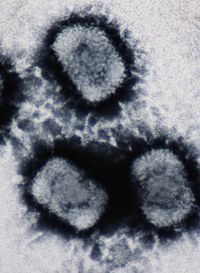
Photo from wikipedia
DNA damage is a common event that occurs during the life span of the majority of cells, as a result of aberrant energy metabolism, exposure to radiation, DNA damaging chemicals,… Click to show full abstract
DNA damage is a common event that occurs during the life span of the majority of cells, as a result of aberrant energy metabolism, exposure to radiation, DNA damaging chemicals, and viral infections. Rapid, sensitive, and economical methods for the detection of DNA damage offer valuable insights into DNA repair, drug genotoxicity, and biomonitoring. The comet assay, or single cell electrophoresis, has emerged as a popular method for detecting single- and double-stranded DNA breaks in single cells. This experimental technique is based on the fact that, when exposed to an electric current, damaged DNA fragments in a gel, migrate farther from the nucleus toward the anode resulting in the shape of a comet. This assay is versatile, quantitative, simple to perform and exhibits high sensitivity; however, consistent experimental conditions must be maintained to ensure assay reproducibility. Electrophoresis can be performed under neutral conditions to detect solely double stranded breaks, or under alkaline conditions to detect both single- and double-stranded breaks. This chapter describes the protocol for both alkaline and neutral comet assays.
Journal Title: Methods in molecular biology
Year Published: 2022
Link to full text (if available)
Share on Social Media: Sign Up to like & get
recommendations!